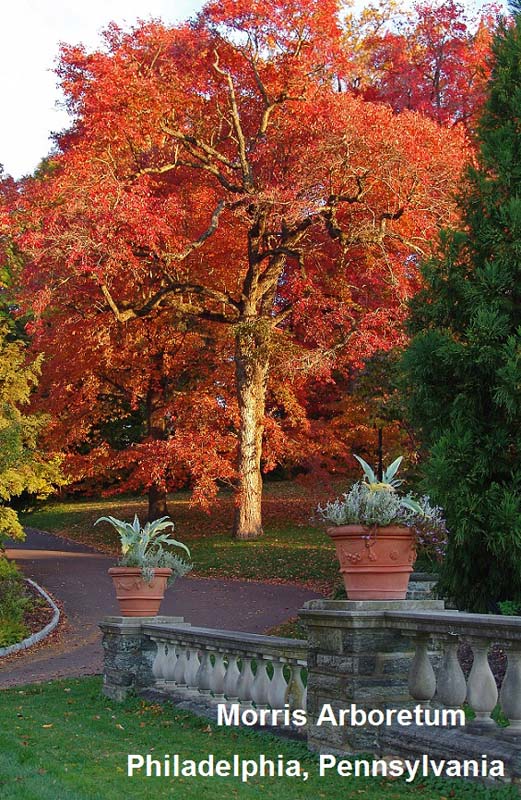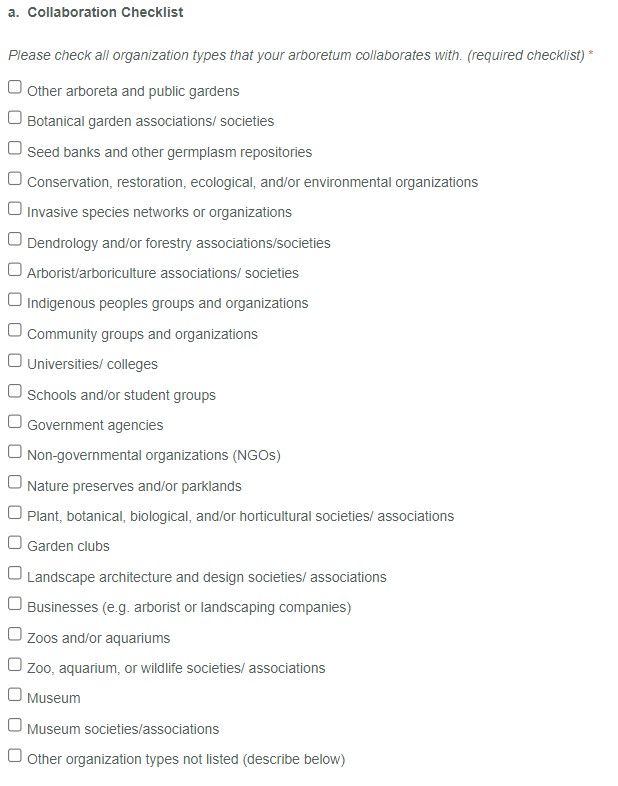.jpg)

- Satisfy all criteria for Level I, Level II and Level III accreditation.
- A scientific and/or conservation staff and capability to collaborate in scientific or conservation activities with other arboreta or organizations related to trees.
- Institutional capacity, stability, and commitment to hold and safeguard plants of collections or conservation value on behalf of the collective interests of the profession.
- Professional capability to collaborate in some way with other arboreta relevant organizations (e.g. public gardens, universities, local government, NGOs, student groups, etc.) preferably with evidence of existing collaboration. Examples of collaborations may include plant evaluations, research projects, in situ or ex situ conservation projects, educational programs, exhibits, public events, interpretation, collecting expeditions, plant exchanges, professional meetings and co-authoring scientific research papers. See checklist below

- Specific consideration of a conservation role See chart below
a. Tree Conservation & Science Action Checklist (required for Level IV)
Please check all activities that your arboretum participates in. Below the checklist, provide details in part 7b (levels III and IV) and part 7c (level IV) as appropriate, about the activities that you checked in the list.
Links and Acronyms (for reference)
Global Conservation Consortia (GCC)
International Union for Conservation of Nature (IUCN) Global Tree Specialist Group
Botanic Gardens Conservation International (BGCI)
BGCI Conservation Action Tracker
Public Gardens as Sentinels against Invasive Plants (PGSIP)
General capacity building for threatened tree conservation
Promote tree conservation through your networks, conferences, presentations, social media, and arboretum website
Host or share GCC educational content (e.g GCC Species Steward panels and/or taxa information sheets; these are provided by the GCC Coordinators)
Carry out education/awareness raising and interpretation among your visitors for threatened trees
Host tree conservation conferences, training workshops, or related meetings (e.g. IUCN Global Tree Specialist Group meeting)
Contribute content, expertise, or other support to tree conservation training materials, such as guidance briefs, manuals, or reports
Host employee(s) who is an active member of the IUCN Global Tree Specialist Group
Report and share information on your tree conservation work using the BGCI Global Tree Portal, including the Conservation Action Tracker
Ex situ tree conservation
Enable researchers or conservationists external to your organization to use your grounds, collections, and/or resources for tree conservation and science work/research
Formal participation in a ex situ conservation project focused on threatened tree species (provide project name in part 7b below)
Partner with Indigenous communities to support culturally significant ex situ tree conservation and restoration activities
Participate in Public Gardens as Sentinels against Invasive Plants (PGSIP) by collecting and sharing data about plants escaping from cultivation in your arboretum
Share threatened tree germplasm/material with other institutions (e.g. for propagation, living collections, seed banks, herbaria, etc)
Develop protocols for propagation of threatened tree germplasm
Host and manage a native or threatened tree nursery
Undertake planting trials for threatened trees
Conduct conservation genetics research on ex situ collections of threatened tree species
Threatened trees included in your collection
Threatened trees included in your collection with interpretation aimed at conservation awareness
Conservation of legacy cultivars
Engage in collections climate change adaptation planning and activities
Provide support to other arboreta to improve their capacity to participate in threatened tree conservation activities (e.g. provide training, financial support, mentorship, threatened tree germplasm/seeds, etc.)
Host a metacollection site as a designated Species Steward for one of the GCCs
In situ tree conservation
Formal participation in an in situ conservation project focused on threatened tree species (provide project name in part 7b below)
Partner with Indigenous communities to support culturally significant in situ tree conservation and restoration activities
Participate in in situ expeditions and surveys to seek out and monitor threatened tree populations
Host and manage a native or threatened tree nursery to repopulate threatened tree species in situ
Conduct conservation genetics research on in situ populations of threatened tree speciesContribute to red listing initiative for trees within a taxonomic group or region
Lead red listing initiative for trees within a taxonomic group or region
Engage in or support in situ habitat restoration or habitat protection in support of priority threatened tree species or ecosystems (e.g. invasive species removal, land protection, reforestation, facilitating sustainable management planning)
Engage in or support in situ conservation and recovery of threatened tree species in the wild (e.g. population monitoring/surveys, reintroduction of seeds/seedlings, assisted migration)
Carry out conservation planning for threatened tree species, e.g. individual species recovery plans, or multi-species plans
View list of Level IV Accredited Arboreta
Level IV sample application download

